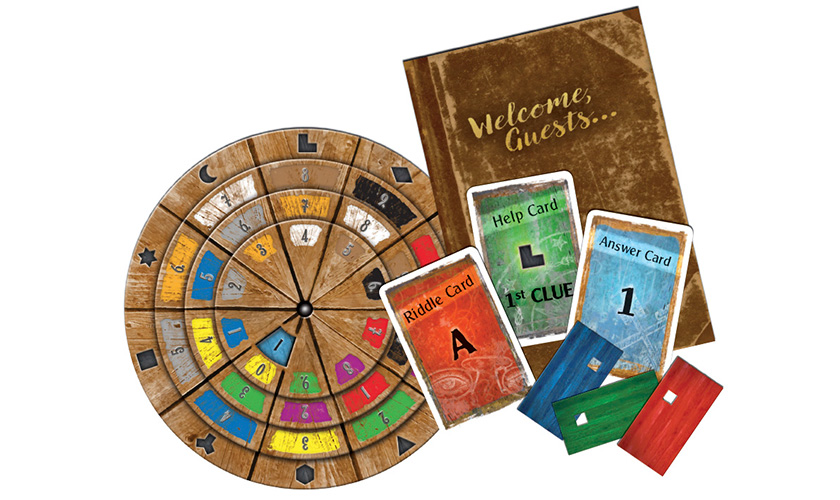I have a new board game review up at Paste today as well, covering Pandemic: Rising Tide, a standalone spinoff of the best cooperative game on the market.
Exit: The Game won the Kennerspiel des Jahres in 2017 in a bit of an upset over the heavily favored and much better-reviewed Terraforming Mars, which I thought was the best complex game (or “expert game,” which is the literal translation of Kennerspiel) of its year. (It also beat Raiders of the North Sea, which I have played just once but enjoyed.) I’m guessing Exit won because it’s novel – it’s a series of cooperative puzzle games that are supposed to mimic the escape-room experience in a tabletop setting. There are other new games in this vein, like Unlock!, but Exit does this really well, with puzzles that you can reasonably solve in the allotted time and, more importantly, a very strong system for helping you if you’re stuck.
Each Exit box gives you a single play, because you’ll be changing destroying components, including tearing or cutting cards, marking up pages, and maybe even disassembling the box. I played four of the games: The Abandoned Cabin (the first in the series), The Forgotten Island, The Polar Station, and The Forbidden Castle, which vary from two to four on the game’s 1-5 difficulty scale, and there was a noticeable difference in the challenges – although I’m not sure the difficult boxes are better, just harder.
One Exit game box comes with three card decks – riddles, solutions, and help cards with hints – plus a booklet specific to that game, a disk of three concentric dials used to decipher codes, and sometimes some “special objects” that may be stencils or windows for finding clues on other cards or pages. You’ll start the game with one of the riddle cards plus the text on the first page of the booklet, and then must find a series of three-digit codes to progress through the game. Each game has roughly ten codes to find, represented by different shapes on the disk, which also help you figure out which cards and pages might work together. The puzzles come in lots of forms, and we found it was better to think a little like a kid to solve many of them. Some of the puzzles are visual – you have to trace things, connect dots, color in cards, fold pages into different shapes, cut pages into strips, all things you’d never expect to do with a board game. Some puzzles are self-contained, while others require you to solve three smaller ones to get each of the digits for the code.


Components from Exit: The Abandoned Cabin.
The Hints deck is the cleverest aspect of Exit’s mechanics by far, and I think it’s what makes this game so playable even if you run into a puzzle you can’t solve. Every puzzle gets three Hint cards with its symbol on it, with the first card telling you what cards, pages, and/or objects you need to solve the puzzle (and maybe one small hint), the second card telling you most of the information on how to solve it, and the third giving the actual solution with an explanation. There were puzzles we solved without any Hints, and a few where we needed all three hint cards to move along. (The game has a timer app you can use, but there really isn’t any need for it except to let you know how long you’ve been playing and nudge you into looking at Hint card.) Having the first Hint card tell you which cards you must have to solve that puzzle is particularly useful if you have pieces of a few puzzles and aren’t sure which one to attack next.
Everything is fair game for solving these puzzles, including things like the game box itself, outside or inside, and each game we played had at least one puzzle that required us to use something that you might assume wasn’t part of the task. (The image on the inside of the top of the box in one game was quite faint, though, which I think is a mistake and makes the game less accessible.) We did find one glitch in The Forgotten Island, as the final riddle’s solution didn’t work; I haven’t heard back from the designer about this, but I’d pass on that particular module for now. The other three were all quite good and my daughter and I were able to solve them in about an hour using a few hints here and there; each had at least one eye-roller solution, but I think that’s the price of entry given that the designers have to come up with ten or eleven puzzles for each box, meaning some are going to be a little weird or ridiculous, especially when the designers, Markus & Inka Brand, try to make the riddles more difficult. The games list for $15-18 and, even as single-play games, they seemed like a good value to us, enough that we bought one after we finished the review copies I’d received (and my daughter will get some more for her birthday). If you’re intrigued, start with The Abandoned Cabin, since it’s first and I think the most straightforward of the four I’ve played.





